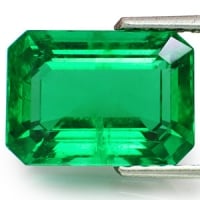Cutting of Emeralds

Traditionally, the cutting of emerald is performed on copper lap, charged with diamond dust and the polishing is carried out on a similar lap with rotten stone as the agent. The best-quality emeralds are almost universally fashioned in the trap-cut style with the corners truncated, giving an elongated octagonal outline, a style which has, owing to the common use for emerald, become known as the “Emerald Cut”.
It is the style of cutting which, owing to its few plane facets, shows the saturated deep velvety green color of emerald to best advantage. Although the mixed cut, with a brilliant-cut top and step-cut pavilion, has been used for emerald, such a fashioning is rare and is said to give a glassy look. Poor quality and badly flawed emeralds are cut en-cabochon or as beads, and much Indian jewellery is set with such stones, which are usually of lower quality emeralds.
Native-cut stones are often ‘doctored’ by boiling in fat which has been suitably coloured. Such treated emeralds tend to show spot at later date, so if any suspicion is aroused it is best to soak the stone for  some time in warm alcohol when some of the false material will dissolve and unmask the trick, and, incidentally, show the true colour of the stone.
some time in warm alcohol when some of the false material will dissolve and unmask the trick, and, incidentally, show the true colour of the stone.
An emerald cut with the table facet at right angles to the optic axis that is at right angles to the length to the prism, will give a yellowish-green colour due to the ordinary ray. At right angles to this direction, that is with the table facet cut parallel to the prism (and of course the optic axis also), the colour is more bluish-green due to about 50 percent of the extraordinary ray. This later colour is often less pleasing to many then the paler shade due to the ordinary ray. Emerald are often carved, especially if the material is of good colour, but marred by many fissures and flaws.
Example of an Emerald-Cut Zambian Emerald:











